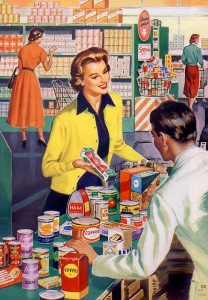
When I was a small tot, I remember going with my mother to the grocery store. She spent $20 each week to feed two adults and a small child. Once I went with a family friend on their shopping trip; they were a little more well off than our family, and that mom spent $40 for a week of food for two adults, a teenage boy, and a small child. At the time, I thought that was an awful lot, but that was before I discovered how much teenagers eat.
In October 1980, I made a note of how much my usual items were costing at my local Kroger in Clear Lake, Texas. I held onto that list for thirty-nine years, and thanks to the internet, was able to compare those prices then with the prices in September 2019 at the same Kroger.
I was surprised at many of the results. After adjusting for changes in package size, I compared the prices against the change in the Consumer Price Index for the same period (approx. 2.938).
Some things are a lot cheaper, notably dairy products:
| Item | Adjusted Price Change since 1980 | |
|---|---|---|
| Dozen large eggs | -64% | |
| Gallon milk | -63% | |
| 24 oz elbow macaroni | -53% | |
| 5 lb Russet potatoes | -50% | |
| Gallon distilled water | -48% | |
| Pound cheddar | -45% | |
| Frozen fish sticks | -40% | |
| Canned tomatoes | -33% | |
| Pound onions | -32% | |
| Canned tuna | -31% | |
| Chips Ahoy cookies | -23% | |
| Kleenex | -16% |
| Item | Adjusted Price Change since 1980 | |
|---|---|---|
| Coca-cola | 62% | |
| Clorox | 52% | |
| Folger’s coffee | 45% | |
| Nabisco Saltines | 37% | |
| Hunt’s ketchup | 37% |
What conclusions can we draw from these data? Why is Clorox higher (remember, this was before corona shortages)? Why are canned tomatoes so much cheaper, but ketchup so much higher? Ketchup is just tomatoes and HFCS – maybe HFCS has gone way up; that would help explain the increase in Coca-cola (which is HFCS and water). And what in the world is up with saltine crackers? Are they putting Clorox in them? How could Chips Ahoy cookies be cheaper, when they’re really just a combination of HFCS and saltines?

